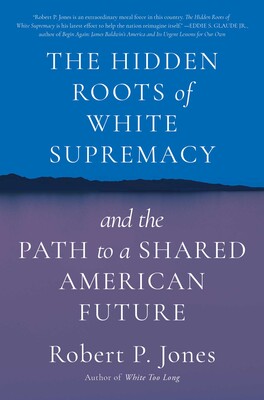The Hidden Roots of White Supremacy: And the Path to a Shared American Future
- By Robert P. Jones
- Simon & Schuster
- 400 pp.
- Reviewed by William Rice
- October 3, 2023
Is atoning for our country’s past sins even possible?

How does a nation atone for past injustices so vast and long-lasting they all but consumed that past? How do citizens paint a new picture of a country’s essential nature that satisfies the vision of targeted groups that have been seeing a harsher image for centuries? Robert P. Jones tackles these imponderables and understandably offers no easy answers in The Hidden Roots of White Supremacy.
The book is a sad, heartfelt, ultimately (and defiantly) hopeful exploration of white racism as wielded against Native Americans and African Africans in Minnesota, Mississippi, and Oklahoma. The violations against Indigenous tribes generally span generations, while the anti-Black crimes covered are discrete 20th-century events, two occurring in 1920. Some of the outrages have in recent years become notorious — the Tulsa Race Massacre and the murder of Emmett Till — while others, like the mass execution of 38 Dakota Indians during the Civil War, have drawn less attention.
The thesis of the book is that the violent dispossession of Native Americans and the enslavement and brutalization of African Americans both sprang from the same source and are best understood and repaired when viewed as two related consequences of a single legal concept: the Doctrine of Discovery. Promulgated by Pope Nicholas V beginning in 1452, the doctrine held that lands occupied by non-Christians were open to seizure by the first believers in Christ who got there.
While the theory of white Christian superiority certainly underlay and traditionally excused atrocities carried out against both groups, how those atrocities unfolded are different enough that it does them each a disservice to be lumped together. Though as a group (with a few enlightened exceptions), white Christians until relatively recently viewed both Native Americans and African Americans as inferior, native peoples were at least perceived as having a communal identity and possessing certain rights. Those rights were of course routinely trampled, but it doesn’t seem like hair-splitting to suggest that it’s less spiritually crushing to have one’s acknowledged rights repeatedly violated than never acknowledged at all.
One telling detail illuminating the crucial difference between the two groups can be found in Jones’ narrative: Some of the Indigenous people traveling the Trail of Tears themselves held African Americans in bondage.
Also, it’s not clear that Christianity or an enunciated doctrine are necessary components of conquest. From time immemorial, more powerful groups have grabbed the territory of less powerful ones. As conquering societies became more sophisticated and concerned with ethical questions, they may have felt the need to clothe their acquisitive behavior in beneficent motives. Long before it became the seat of Christianity, Rome reassured itself that its marching legions were bringing civilization to the benighted inhabitants of savage lands. As recently as the last century, Shinto Japan and basically pagan Nazi Germany used the same reasoning for brutal invasions and occupations.
While conquest and subjugation are as old as human history, there is no precedent for the peculiarly crippling cruelties of the trans-Atlantic slave system that began in the early 16th century and flourished for 350 years. Slavery within Africa and elsewhere was often imposed on near neighbors vanquished in battle, with the enslaved and enslavers sharing much culture and varying little in appearance. By contrast, in the industrialized slavery practiced by Europeans transporting Africans to the Americas, thousands of miles of ocean created an unbreachable barrier to the enslaved people’s original land, family, and culture. And differences in appearance — skin color — became inextricably linked to and were even (according to slavery’s apologists) an explanation for the condition of servitude.
Ranking injustices may seem a pointless and even malicious exercise, but delineating differences in the experiences of various groups can also be viewed as the kind of clear-eyed historical thinking Jones is calling for in his book.
What’s to be done after all this time and all these wrongs? Repair begins, Jones rightly tells us, with remembering, acknowledging, and accepting — and in the case of the three anti-Black crimes he chronicles, those first steps have been taken, however belatedly. Agreeing on, let alone providing, material compensation is a whole other disheartening puzzle. In the book’s most biting prose, Jones attacks the beneficiaries of white supremacy’s myriad crimes who’ve decided compensating victims is impossible:
“Greed spawns a million schemes, while repentance throws up its hands.”
But the few voluntary compensation projects the author describes feel more like performance than substance. And though he warns against engaging maximalist positions, it does seem that paying for 3.8 million square miles of stolen land or 250 years of uncompensated labor requires a monetary sacrifice beyond the bounds of good intentions. Maybe, as Jones implies, there is a solution we don’t yet see. And until we can figure out how to properly deal with the past, we still have the present. Let’s try to make better use of it.
William Rice is a writer for political and policy-advocacy organizations.
_80_122.png)
